All About Visiting Yellowstone in February
The benefits, drawbacks, activities and other features of visiting Yellowstone in February.
Updated: 8/25/22
February in Yellowstone National Park is an absolute winter wonderland. Nothing beats the snowy meadows, hot steam rising from a geyser to meet the bitterly cold air, or an icicle-covered bison trudging through a white plain. There are many benefits to visiting in February, as well as some drawbacks. If you can make it to Yellowstone you are sure to have an incredible trip and leave with an appreciation for the snow and solitude of winter.
Benefits of Visiting in February
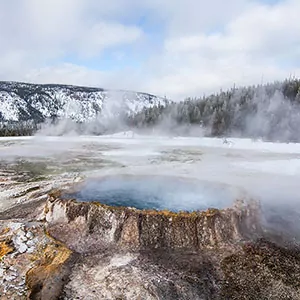 The biggest benefit of visiting in February is the wildlife viewing. Most animals make their way to the meadows and valleys because the high country is too cold in the winter. The high concentration of animals at lower elevations makes it much easier to view them. Bison, bighorn sheep, foxes, wolves, and elk are plentiful in Yellowstone’s valleys. The snow is often beneficial to those wanting to see wildlife as the dark coats of many creatures are contrasted to the white of the snow and therefore make them easier to spot. Visitors will also have a better chance of seeing– or at least seeing the footprints of– some of the park’s more elusive hunters such as mountain lions, bobcats, lynx, and badgers. While it may not be intuitive, winter is one of the best times to view wildlife in the park as many of the ungulates will stand still for hours to conserve energy and heat, making winter photos easy.
The biggest benefit of visiting in February is the wildlife viewing. Most animals make their way to the meadows and valleys because the high country is too cold in the winter. The high concentration of animals at lower elevations makes it much easier to view them. Bison, bighorn sheep, foxes, wolves, and elk are plentiful in Yellowstone’s valleys. The snow is often beneficial to those wanting to see wildlife as the dark coats of many creatures are contrasted to the white of the snow and therefore make them easier to spot. Visitors will also have a better chance of seeing– or at least seeing the footprints of– some of the park’s more elusive hunters such as mountain lions, bobcats, lynx, and badgers. While it may not be intuitive, winter is one of the best times to view wildlife in the park as many of the ungulates will stand still for hours to conserve energy and heat, making winter photos easy.
Another benefit to visiting Yellowstone in February is the lack of crowds. The month of July sees 4 million visitors, while the winter only sees 0.3 million. Since there are fewer people, your chances for solitude grow exponentially; this means you are very unlikely to run into long lines of traffic or be forced to circle around parking lots like a vulture searching for a spot. The lack of crowds also means that accommodations will be more readily available and more affordable compared to summer. In peak season, accommodations can book up to a year in advance, but you are more likely to find a place to stay just a few weeks before your stay in winter. There are two lodges within the park that can remain open in the winter, one in Mammoth Hot Springs that you can access by car and the other at Old Faithful that must be accessed with over-snow vehicles such as snowmobiles or snow coaches. Both of these lodges close at the end of February for the season, but accommodations outside the park’s northern and northeastern entrances in Gardiner and Cody remain open throughout the season.
Visiting Yellowstone during the winter is an extremely different experience than visiting any other time of year. You will see the park in a way that very few people do. Another obvious benefit of visiting in February is the sheer beauty of the landscape, ethereal and hushed with snow. Yellowstone in winter provides excellent photo opportunities, especially of the park’s geothermal features spewing steam amidst a snowy landscape. You will also get to participate in some of the park’s winter sports in February that only a few visitors get to experience. From over-snow travel such as snowmobiles and snow coaches to cross-country skiing and snowshoeing, you will have endless opportunities to experience this snowy wonderland.
Drawbacks of Visiting in February
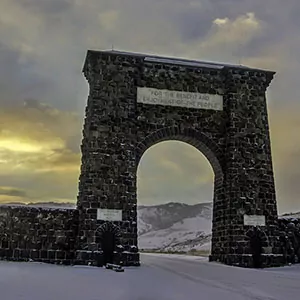 One of the biggest drawbacks to visiting the park in February is that most of the roads are closed to private vehicles. The only road that is open for visitors to drive themselves is the road from the north entrance, at Gardiner, to the northeast entrance, at Cooke City. Snow coach transportation is available if you want to get deeper into the park. Many people find this to be a novel alternative to traditional travel, but it can become expensive. Another drawback to February is that it is very cold. Subzero temperatures are not uncommon and visitors need to be prepared for extreme and unpredictable weather such as snowstorms, whiteouts, and whipping winds. This not only means that visitors need to be prepared with gear and clothing to withstand this kind of conditions (which incidentally is rather expensive if you don’t already have the equipment), but they also need to be prepared with a good book or a deck of cards to keep themselves busy if the weather prevents them from spending time outside. Particularly visitors who are staying at the Old Faithful Lodge– where the average low is 0 degrees– need to know that the majority of their trip of a week or more might be spent inside the lodge due to blinding snowstorms outside. While the park in winter is gorgeous when you can see it, the weather poses a real threat to preventing visitors from doing anything but looking out the window at the blizzard going on outside.
One of the biggest drawbacks to visiting the park in February is that most of the roads are closed to private vehicles. The only road that is open for visitors to drive themselves is the road from the north entrance, at Gardiner, to the northeast entrance, at Cooke City. Snow coach transportation is available if you want to get deeper into the park. Many people find this to be a novel alternative to traditional travel, but it can become expensive. Another drawback to February is that it is very cold. Subzero temperatures are not uncommon and visitors need to be prepared for extreme and unpredictable weather such as snowstorms, whiteouts, and whipping winds. This not only means that visitors need to be prepared with gear and clothing to withstand this kind of conditions (which incidentally is rather expensive if you don’t already have the equipment), but they also need to be prepared with a good book or a deck of cards to keep themselves busy if the weather prevents them from spending time outside. Particularly visitors who are staying at the Old Faithful Lodge– where the average low is 0 degrees– need to know that the majority of their trip of a week or more might be spent inside the lodge due to blinding snowstorms outside. While the park in winter is gorgeous when you can see it, the weather poses a real threat to preventing visitors from doing anything but looking out the window at the blizzard going on outside.
Additionally, even if the weather is good and you are able to spend time outdoors, the short days of winter will severely limit your outdoor activities or the time in which you are able to travel if you are on a backcountry trip. The temperature in the mornings and evenings tapers off from the (relative) warmth of midday quickly. Visitors should be aware of the impending dangers of hypothermia and frostbite if they are caught outside once the temperature starts to dip. Yellowstone in winter is no joke and the dangers of severe injury or even death are imminent if you are not prepared. Other dangers that come with venturing on a hike or into the backcountry such as avalanches, wildlife, geothermal features, and overheating can all also cause serious risk. While Yellowstone at any time of the year comes with some inherent risks due to the volcanic activity and wildlife, winter comes with some additional risks that summer does not. While certainly not a reason to not visit the park, visitors should be aware of the dangers of visiting in February.
Things To Do In February
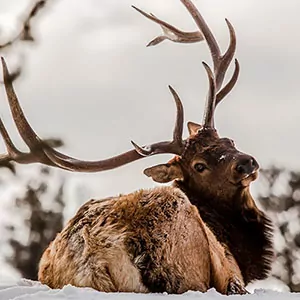
Many trails at lower elevations are open in the winter, giving you a great opportunity to snowshoe or cross-country ski. Snowshoes and skis are available for rent at Mammoth Hot Springs and Old Faithful. Snowshoe tours and cross-country ski tours are also available, and give you a unique perspective of the park—highlighting geysers, frozen waterfalls, and plentiful wildlife in snow-covered meadows, all with knowledge from a Yellowstone expert. Of course, many of the trails especially around Canyon Village are not accessible except by over-snow vehicles, which can be operated privately with permits or with a tour company. Many companies offer snow coach transportation from any entrance of the park to Old Faithful or the Grand Canyon of Yellowstone. Some companies also offer snowmobile tours and the National Park Service has a lottery system for a Non-Commercially Guided Snowmobile Access Program —where visitors over the age of 18 can snowmobile through the park without a commercial guide. These are wonderful ways to explore the park further since you can’t drive the roads yourself.
Wildlife viewing is also a popular activity in the park this time of year in Lamar Valley and the Mammoth Hot Springs area which can be accessed by private vehicle. Many of the mammals have congregated in the valleys and meadows because of the (relatively) warmer temperatures, more readily accessible food, and lower levels of snow that require less energy to trudge through. Seeing these animals able to survive in such adverse conditions is amazing and the photography opportunities of bison with their backs covered in snow are truly one of a kind. Some of the smaller animals can also be a joy to watch in winter such as coyotes plunging head first into the powder hunting for voles, or the pure white long-tailed weasels and snowshoe hares bounding across the snow. If you have access to over-snow travel, many of the sights to see in the park are even more stunning in winter, without the crowds and with snow all around. The Grand Canyon of Yellowstone in particular offers fantastic views as well as snowshoeing and cross-country ski trails.
If the weather prevents you from spending time outside (which is not entirely out of the question), the Old Faithful Visitor Center and Museum is open in February and the Albright Visitor Center near Mammoth Hop Springs is open year-round. These provide excellent information about the park and the surrounding area as well as engaging interpretive information that makes a visit well worthwhile. There are also plenty of options for entertainment and dining available just outside the park through the northern entrance in Gardiner, MT, where you can even try bison burgers.
Things to see in february
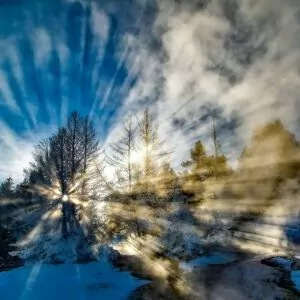 Yellowstone in February affords visitors some of the most fantastic sights to see in the park. From the snow-topped mountains to abundant wildlife, and hydrothermal futures to alpine scenes, there are almost endless things to see in this winter wonderland. However, February in Yellowstone does come with some challenges as you will need to take over snow travel to any location that is not on the road from the north entrance to the northeast entrance. Whether you choose to take over snow travel or not, there is still much to see. Below we have compiled a list of some of the must-see sites in February along with an indication of whether you can drive to them or need to take over snow travel. Make sure to do your own research as well to see what piques your particular interest in the park as this list is by no means exhausted.
Yellowstone in February affords visitors some of the most fantastic sights to see in the park. From the snow-topped mountains to abundant wildlife, and hydrothermal futures to alpine scenes, there are almost endless things to see in this winter wonderland. However, February in Yellowstone does come with some challenges as you will need to take over snow travel to any location that is not on the road from the north entrance to the northeast entrance. Whether you choose to take over snow travel or not, there is still much to see. Below we have compiled a list of some of the must-see sites in February along with an indication of whether you can drive to them or need to take over snow travel. Make sure to do your own research as well to see what piques your particular interest in the park as this list is by no means exhausted.
Old Faithful: No visit to Yellowstone is complete without a visit to Old Faithful, the most famous geyser in the world. While most geysers are unpredictable and erupt infrequently, Old Faithful has lived up to its name and erupts multiple times a day to awe visitors. Varying only 30 minutes in eruptions in the last 30 years, you won’t want to miss out on the fantastic sight of the geyser spewing hundreds of gallons of boiling water up into the air. Accessible only by over-snow traffic
Mammoth Hot Springs: Perhaps the most uniquely formed hydrothermal feature in the park, Mammoth Hot Springs is formed on terraces instead of in pools or ponds. The boiling hot water travels down a series of fountains, tinged with white and copper, that is often said to be more beautiful than any fountain man could have designed. The area features extensive boardwalks and hiking trails so that you can take in this amazing site. Accessible throughout winter by car
Lamar Valley: While Hayden Valley is the more popular of these two in the summer for wildlife viewing, Lamar Valley is excellent for many reasons, not the least of which is that you can drive to it. Hundreds of bison gather here for the winter and this is also the best place to see wolves in the park who have come down from higher elevations for the warmer temperatures and more abundant food. A low land of sweeping meadows surrounded by higher ground, this valley is the perfect spot for wildlife viewing and is not to be missed in winter. Accessible throughout winter by car
Norris Geyser Basin: One of the hottest and most active geyser basins in the park, Norris Geyser Basin is not to be missed any time you visit Yellowstone. While the bubbling hot springs and spewing geysers are a treat to see any time of the year, they are especially remarkable when surrounded by a fresh layer of snow. Accessible only by over-snow traffic
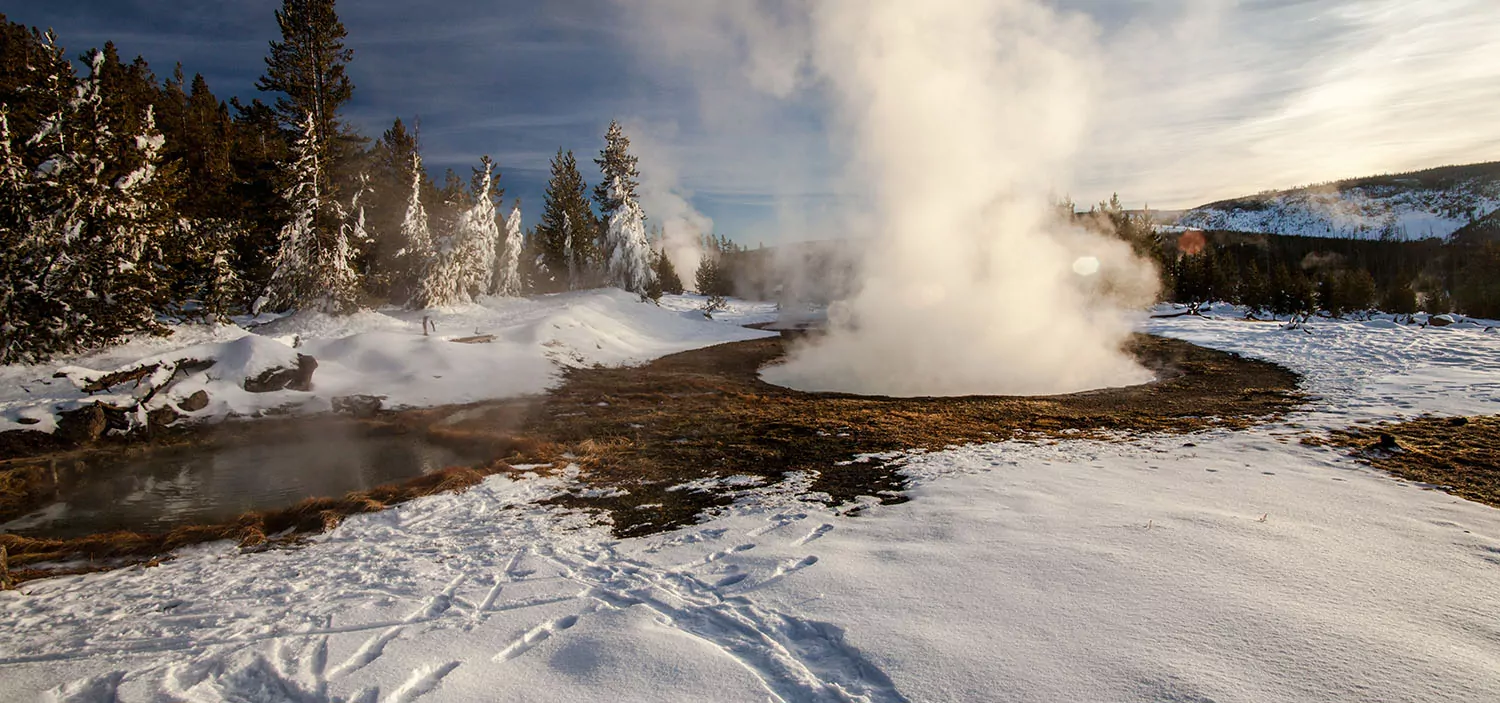
Hiking in February
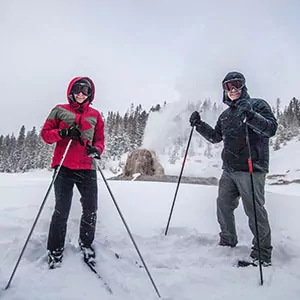 There is a lot of snow in Yellowstone in February, meaning that you’ll probably be hiking in more than just your hiking boots. Snowshoeing and cross-country skiing are incredible ways to experience the backcountry of Yellowstone in the winter. Many trails are open for these activities near Mammoth Hot Springs, Old Faithful, and the Grand Canyon of Yellowstone. Winter guided tours are a great way to experience the park. With gear, lodging, meals, and transportation included, you can relax and enjoy Yellowstone in a way that not many others do. Adventurous visitors can embark on backcountry ski expeditions with winter camping but Yellowstone backpacking trips in the conventional sense are not possible in February.
There is a lot of snow in Yellowstone in February, meaning that you’ll probably be hiking in more than just your hiking boots. Snowshoeing and cross-country skiing are incredible ways to experience the backcountry of Yellowstone in the winter. Many trails are open for these activities near Mammoth Hot Springs, Old Faithful, and the Grand Canyon of Yellowstone. Winter guided tours are a great way to experience the park. With gear, lodging, meals, and transportation included, you can relax and enjoy Yellowstone in a way that not many others do. Adventurous visitors can embark on backcountry ski expeditions with winter camping but Yellowstone backpacking trips in the conventional sense are not possible in February.
The Canyon Rim Ski Trail for cross-country skiing is a great option for those looking for unique views as a 4.5-mile moderate ski around the rim of the Grand Canyon of Yellowstone. There is also a North Canyon Trail along the Grand Canyon of Yellowstone that is also moderate but shorter, coming in at 3 miles. If you’re looking for something on the easier side, Cascade Lake Ski Trail and Old Canyon Bridge Ski Trail are both great options. Always talk to a ranger if you can before you head out on a ski or snowshoe adventure about the current conditions and what trail would be best for your skill level. Snowshoers are asked not to walk directly on ski tracks as the indentation can be a hazard to skiers. Those venturing out onto the trails should also be aware of which trails require over-snow transportation to access and which can be accessed by car.
While venturing onto trails in Yellowstone in the winter is a rewarding experience, it does come with some risks and hikers should be aware of the dangers they might encounter while out on the trail. Trails in winter are typically unmarked so those even out for just a day hike should have navigational equipment to be able to find the trail under the snow if it is not groomed. Any wildlife that you see should not be approached and while it is uncommon to see bears in the winter as they are hibernating, it is not impossible that they will venture out of their dens. The weather can turn quickly in February and often dips below zero in the evenings, so hikers should be aware of the forecast and be prepared to turn back if need be. Some of the trails that are not groomed in the backcountry that day hikers might still encounter have avalanche zones, so make sure you know the proper procedures for crossing an avalanche area or avoid trails that are avalanche prone.
Skiers and snowshoers should also be aware of the dangers of geothermal areas in the snow. Stay on the trail and never approach geothermal areas as what looks like solid ground may only be a thin layer of ice over scalding water. Hypothermia and overheating are both very real dangers in the park, especially while doing aerobic activities like cross-country skiing. Dress in layers and make sure you know how to recognize the symptoms of both of these conditions. Drink plenty of water throughout the day even though it is cold and carry it in insulated bottles so that it does not freeze. Even if you’re an advanced snowshoer or skier, plan your time generously when beginning your trail. Unpredictable conditions can inhibit how fast you complete the trail and you do not want to be caught in the elements after dark when the temperature begins to drop sharply. Even though hiking in Yellowstone in the winter comes with some risks, it is well worth the experience.
Backpacking in Feburary
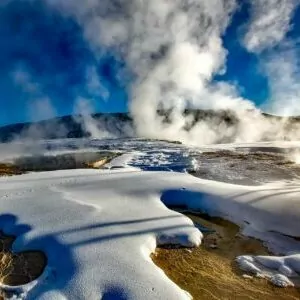 Traditional backpacking in Yellowstone in February is not possible due to the snow and conditions, but adventurous (and knowledgeable) visitors can venture into the backcountry on cross-country skis or snowshoes and truly experience the wild of Yellowstone’s winters. There are many different options for itineraries for backcountry trips as well as guided tours, but you should always keep in mind which trails will be accessible by car and which will require over-snow travel on snowmobiles or snow coaches. Always check with a ranger and online to make sure that the area you were planning to get a permit for is available to hike in as some areas in the backcountry are closed because of high concentrations of wildlife, bear management, or increased dangers of some other kind.
Traditional backpacking in Yellowstone in February is not possible due to the snow and conditions, but adventurous (and knowledgeable) visitors can venture into the backcountry on cross-country skis or snowshoes and truly experience the wild of Yellowstone’s winters. There are many different options for itineraries for backcountry trips as well as guided tours, but you should always keep in mind which trails will be accessible by car and which will require over-snow travel on snowmobiles or snow coaches. Always check with a ranger and online to make sure that the area you were planning to get a permit for is available to hike in as some areas in the backcountry are closed because of high concentrations of wildlife, bear management, or increased dangers of some other kind.
While back-country camping in Yellowstone comes with its fair share of dangers, it’s a very rewarding experience for those willing to put in the effort to gain the knowledge and get the gear necessary to do it. The National Park Service has put together a fantastic video and page on their website that goes over many of the regulations for camping in the backcountry as well as tips on how to make your trip more enjoyable.
One of the biggest points is that those venturing into the backcountry should be aware of all the dangers they might encounter and how to deal with them if something goes wrong. Winter camping requires much more gear than summer backpacking does, and you will need to know how to use your gear and test it out in winter conditions before you rely on it in the backcountry. Yellowstone has designated backcountry campsites some of which have hanging poles for food. You will need to bring your own rope to hang your food about 30 feet above the ground or bring approved bear-resistant containers. Do not approach any wildlife that you see and if you do encounter wildlife make sure to leave them a clear path that is not through deep snow for them to walk away from you. Subzero temperatures, whiteouts, whipping winds, snow storms, active geothermal areas, deep snow, and avalanches are some of the dangers that you might encounter. Dress appropriately to avoid hypothermia, frostbite, and overheating as all of these are real threats in Yellowstone’s backcountry. Leave your itinerary with someone who is not going with you so that rescue teams will know you are overdue if something goes wrong and make sure you have navigational tools as many backcountry trails are not marked in winter and can be difficult to navigate especially in a white out or snow storm. It’s very important to know your limits and to know when to turn around if need be. Because Yellowstone has designated sites, you will not be able to stop and camp somewhere if you overestimate how far you can travel in one day. While hiking in the backcountry in Yellowstone during the winter can be dangerous, those who embark on this activity safely will get to experience the wilderness like few have and without a doubt remember it for life.
Weather in February
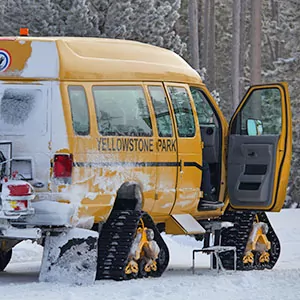
Yellowstone is a large park with elevations ranging from 6,000 to 11,000 feet. Thus, the weather can change dramatically depending on your location and the elevation. February is still very much in winter for Yellowstone, and you should expect deep snow and cold temperatures. The average temperature for Mammoth Hot Springs is a high of 34 degrees and a low of 13 degrees Fahrenheit (-10 degrees Celsius). At Old Faithful, average temperatures are a high of 28 degrees Fahrenheit (-2 degrees Celsius), and a low of 0 degrees Fahrenheit (-17 degrees Celsius). On average, there are 8 days of snow in Yellowstone in February. Keep in mind that these temperatures are only averages, and the park can experience much colder temperatures and receive much more snow. Especially for those traveling in the backcountry, temperatures of -20°F or colder can be encountered.
Such extreme conditions can make visiting the park cumbersome as it requires more gear and knowledge. The only road open for private vehicles is the one from the north entrance to the northeast entrance, passing through Lamar Valley, Mammoth Hot Springs, and the tower area. However, this road can be icy, and visitors are advised to drive slowly and safely as they will be sharing it with wildlife, which sees the benefits of walking on the road instead of trudging through deep snow. All other roads in the park are only accessible by over-snow vehicles such as snowmobiles and snow coaches. Visitors should be prepared for the worst they might encounter, as those who come to Yellowstone in winter unprepared may find it best to be cold and miserable, and at worst, they could be in danger of hypothermia or frostbite. Most cases of hypothermia in the park occur when the temperature is between 30 and 50°F, so make sure you dress in layers and know how to recognize the symptoms of this condition. Visitors should also be aware that adverse weather may affect their trip itineraries and force much of their time to be spent inside. Especially if you are staying at Old Faithful Lodge, bring a good book or some board games to keep yourself busy, as a whiteout or blizzard could essentially force you to stay inside for much of your trip. This is simply the risk you take when you come into Yellowstone in winter, not only for your safety but also for whether the weather will allow you to see the park. Also, be aware of thin ice over lakes, rivers, and geothermal areas. It is never safe to leave the trails around geysers and hot springs, as what appears to be solid ground may only be a thin layer of ice over boiling water. While the snow does make the park beautiful, it can pose some problems for visitors, so make sure to read up on the forecast and be prepared for whatever weather comes your way.
Wildlife in February
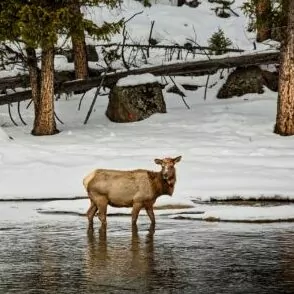
While it may not seem intuitive, winter is a fantastic time to see wildlife in Yellowstone. The high country is very cold and covered in deep snow, so many of the animals congregate in the valleys and meadows due to the relatively warmer temperatures, abundant food, and smaller amounts of snow. Lamar Valley and Hayden Valley, in particular, often have huge herds of bison, as well as many elk, pronghorn, and moose. Your chances of seeing bison and elk in the park are almost 100%, as these ungulates are very common and often walk along the roads to avoid trudging through deep snow. It’s amazing to see these creatures live in such extreme conditions, as bison will often stand still for hours to conserve heat and energy. While your chances of seeing a bear, whether brown or black, in the park, are significantly reduced in winter due to hibernation, it is not impossible for them to leave their dens and for visitors to see them.
Some of the smaller wildlife is also a joy to watch, such as a pure white long-tailed weasel or snowshoe hares bounding across the snow, or a coyote plunging headfirst into the powder hunting for voles. Wolves are one of the most sought-after wildlife sightings in Yellowstone, as the park is the best place in the lower 48 states to see these predators. In winter, especially, the dark coats of about 50% of the wolves in the park stand out against the snow, making them easier to spot from long distances. Visitors in Lamar Valley will often set up tripods on the side of the road for hours, waiting for a pack to come by that has come to the valley for the warmer temperatures and the abundance of food, such as the bison and elk that have come for their readily available food.
The rivers are also great places to look for wildlife, as waterfowl and many mammals of the weasel family, such as beavers, river otters, martens, and badgers, also live in the park. The snow can be an asset to visitors trying to see some of the more elusive animals that live in the park, or at least help them see their tracks. Mountain lions, bobcats, wolverines, and Canadian lynx all call the park home but are rarely seen by visitors. The snow preserves the tracks of these animals better than dirt, so those in the backcountry might be able to see at least the evidence of a passing animal.
Recommended wildland trips in February
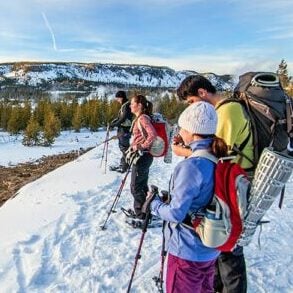 Planning a trip to Yellowstone in February can be overwhelming as you try to keep up with the conditions, the weather, and all the other logistics that go into planning a trip to a national park in winter. Bypass the headache by booking with a guiding company that will take care of logistics for you. Wildland Trekking offers many trips to Yellowstone in a variety of styles that include backpacking, basecamp tours, inn-based tours, llama treks, and day hikes.
Planning a trip to Yellowstone in February can be overwhelming as you try to keep up with the conditions, the weather, and all the other logistics that go into planning a trip to a national park in winter. Bypass the headache by booking with a guiding company that will take care of logistics for you. Wildland Trekking offers many trips to Yellowstone in a variety of styles that include backpacking, basecamp tours, inn-based tours, llama treks, and day hikes.
Wildland Trekking does offer an inn-based tour in February that centers around trekking with snowshoes in different areas in the park. You can say goodbye to trying to figure out which trail is safe, has the best conditions, or is appropriate for your fitness level as our expert guides will take care of all of the details. Our Yellowstone Snowshoe Traverse is a great way to experience different areas of the park every day before returning to cozy lodges at night to relax and sit in front of the fire. Included in your cost are meals, local transportation, accommodations, and much of the gear that you will need, including snowshoes, ski poles, and a backpack. You won’t want to miss out on this fantastic Yellowstone adventure that takes all of the worry out of planning a trip in winter so that you can relax and soak up the scenery.
Join a Guided Hiking Adventure
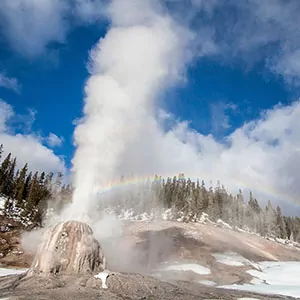 Yellowstone National Park is home to some of the most epic and amazing hiking vacations in the world. Wildland Trekking offers trips with the best of Yellowstone: geysers, waterfalls, views, wildlife, solitude, adventure, and fascinating natural and cultural interpretation.
Yellowstone National Park is home to some of the most epic and amazing hiking vacations in the world. Wildland Trekking offers trips with the best of Yellowstone: geysers, waterfalls, views, wildlife, solitude, adventure, and fascinating natural and cultural interpretation.
Guided Yellowstone treks are all-inclusive which covers permits; local transportation (excluded on certain tours); meals; equipment; safety systems and professional hiking/wilderness guides; all of which allow visitors to maximize their time in Yellowstone and focus entirely on enjoying the Park.
YELLOWSTONE ADVENTURE TOURS
- GUIDED BACKPACKING ADVENTURES: these are for people interested in an authentic Yellowstone adventure away from the roads and crowds.
- LLAMA TREKS: on these innovative trips, guests hike with light day packs and camp near in stunning backcountry locations.
- INN-BASED PACKAGES: these tours are all-inclusive packages with lodging, amazing daily hikes, expert guides, meals, transportation and more!
- CAMPING-BASED HIKING PACKAGES: camping-based hiking packages provide all-around hiking experiences of Yellowstone on wonderful outdoor vacations.
- DAY HIKE TOURS: maximize your day in Yellowstone on a fully guided, award-winning hiking tour on one of the Park’s best trails.





